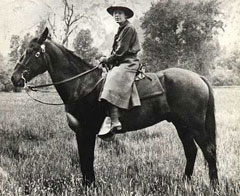For tens of thousands of years, humans have changed, and have been changed by, this place we now call Yosemite.
The Ahwahneechee lived here for generations,
followed by the arrival of Europeans in the mid-1800s.
The rugged terrain challenged many early European travelers,
with just a few—only 650 from the mid-1850s to mid-1860s—making the journey to Yosemite Valley by horseback or stage.
By 1907, construction of the Yosemite Valley Railroad from Merced to El Portal eased the journey, thereby, increasing visitation.
Today, about 4 million people enter the park’s gates to explore Yosemite.
We can learn from the stories of those who walked Yosemite’s trails before us and honor the echoes of their distant footsteps
that have led to conscious preservation.
Nowadays, Yosemite National Park is a United States National Park spanning eastern portions of
Tuolumne, Mariposa and Madera counties in the central eastern portion of the U.S. state of California,
commonly referred to as Northern California.The park, which is managed by the National Park Service,
covers an area of 747,956 acres (1,168.681 sq mi; 302,687 ha; 3,026.87 km2)
and reaches across the western slopes of the Sierra Nevada mountain chain.
Over 3.7 million people visit Yosemite each year: most spend the majority of their time in the seven square miles (18 km2)
of Yosemite Valley. Designated a World Heritage Site in 1984,
Yosemite is internationally recognized for its spectacular granite cliffs, waterfalls, clear streams, giant sequoia groves,
and biological diversity. Almost 95% of the park is designated wilderness.
Yosemite was central to the development of the national park idea.
First, Galen Clark and others lobbied to protect Yosemite Valley from development,
ultimately leading to President Abraham Lincoln's signing the Yosemite Grant in 1864.
Later, John Muir led a successful movement to establish a larger national park encompassing not just the valley,
but surrounding mountains and forests as well—paving the way for the United States national park system.
Yosemite is one of the largest and least fragmented habitat blocks in the Sierra Nevada,
and the park supports a diversity of plants and animals.
The park has an elevation range from 2,127 to 13,114 feet (648 to 3,997 m) and contains five major vegetation zones:
chaparral/oak woodland, lower montane forest, upper montane forest, subalpine zone, and alpine.
Of California's 7,000 plant species, about 50% occur in the Sierra Nevada and more than 20% within Yosemite.
There is suitable habitat for more than 160 rare plants in the park,
with rare local geologic formations and unique soils characterizing the restricted ranges many of these plants occupy.
The geology of the Yosemite area is characterized by granitic rocks and remnants of older rock.
About 10 million years ago, the Sierra Nevada was uplifted and then tilted to form its relatively gentle western slopes
and the more dramatic eastern slopes. The uplift increased the steepness of stream and river beds, resulting in formation of
deep, narrow canyons. About 1 million years ago, snow and ice accumulated,
forming glaciers at the higher alpine meadows that moved down the river valleys.
Ice thickness in Yosemite Valley may have reached 4,000 feet (1,200 m) during the early glacial episode.
The downslope movement of the ice masses cut and sculpted the U-shaped valley that attracts so many visitors
to its scenic vistas today.
People:
Seven present-day tribes descend from the people who first called this area home.
As Europeans arrived in the mid-1800s, violent disruption ensued that displaced the native populations.
Early white settlers arrived and hosted writers, artists, and photographers who spread the fame of "the Incomparable Valley" throughout the world.
Places:
Within Yosemite's history, various populations thrived and left their mark.
From historic mining sites, the remains from miners who came to the Sierra to seek their fortune in gold,
to early lodging establishments, like the Wawona Hotel,
offered a more primitive setting for the Valley's first tourists and today's visitors,
and more elegant lodging, like The Ahwahnee, was added to satisfy those looking for comfort.

Clare Marie Hodges
Stories:
History books detail the Mariposa Battalion entering Yosemite Valley in 1851 to remove the Ahwahneechee.
As Euro-American settlement occurred, people arrived on foot, on horseback and by rail to rustic hotels.
Parts of the landscape were exploited, spurring conservationists to appeal for protections.
President Abraham Lincoln signed an 1864 bill granting Yosemite Valley and the Mariposa Grove to the State of California.
John Muir helped spark the creation of Yosemite National Park in 1890.
Collections:
Yosemite’s resources fill a flourishing museum collection of more than 4 million items.
The museum maintains a research library with some 10,000 books relevant to Yosemite, as well as photographs and articles.
And, recently, an oral history project has collected interviews of people's park stories, events,
and experiences that captures eye-witness evidence of the past.
(Photos: View the
NPS Historic Photo Collection
through the Harpers Ferry Center for close to 90 images of Yosemite.)
Preservation:
The studies of archeology and architecture honor Yosemite's past.
Archeologists systematically study the things left behind to uncover clues about historic and pre-historic cultures,
economic systems, settlement patterns, demography, and social organizations.
Both landscape architecture and structural architecture are disciplines that help us understand
the drivers behind development and choices to make human impacts compatible and enhance the visitor's experience
with their surroundings. Yosemite structures representing the belief that buildings should blend in with natural surroundings.
Research and Studies:
Ongoing scientific research abounds at Yosemite from vista management to sound-scape preservation to human carrying capacity issues.
Yosemite has been building its Division of Resource Management and Science,
serving as a public meeting place for scientific symposiums with papers presented at monthly forums.
In addition, the division processes hundreds of research permits every year for its staff and outside interests.





